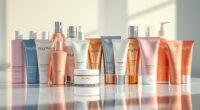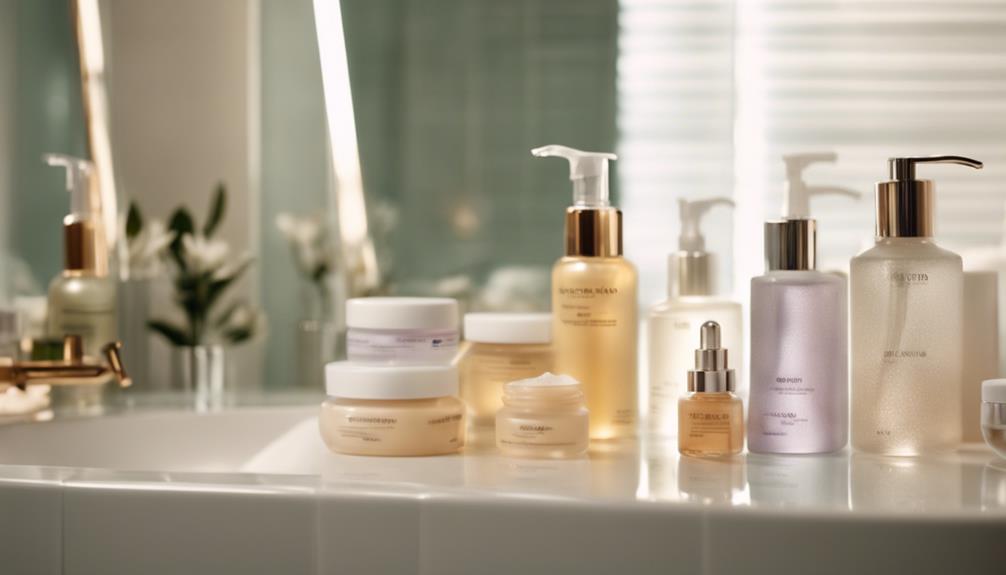Exploring sunless tanning options gives you a variety of products like mousses, drops, sprays, and serums to achieve a natural glow without UV exposure. You can choose between quick-acting bronzers for instant color or long-lasting formulas like DHA-based lotions for a gradual tan. Proper application and skin preparation are key for even results, and extending your tan requires good aftercare. If you want to learn more about the best products and tips, keep exploring.
Key Takeaways
- Various formulations like mousses, drops, sprays, and serums offer customizable and convenient tanning options suited to different preferences.
- Key ingredients such as DHA and erythrulose provide safe, UV-free color development, with safety tips to minimize skin risks.
- Proper preparation, application techniques, and aftercare ensure even, natural-looking, and long-lasting sunless tans.
- Temporary bronzers offer quick, wash-off color, while DHA-based formulas provide longer-lasting results that fade gradually.
- Popular brands like St. Tropez, Isle of Paradise, and Coco & Eve are praised for effective, innovative products with positive consumer feedback.
Types of Sunless Tanning Products and Their Uses
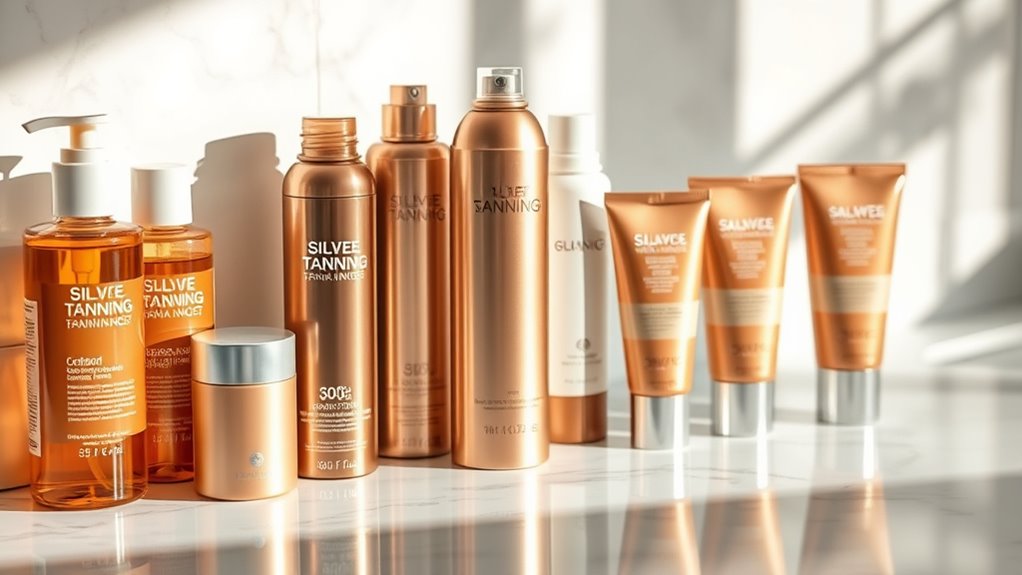
Sunless tanning products come in a variety of types, each designed to suit different preferences and needs. Mousses are lightweight, buildable formulas that offer even application with color guides, making it easy to achieve a streak-free glow. Drops are versatile, mixable serums that let you customize the tan depth by blending with moisturizers. Waters and mists are hydrating, sprayable formulas perfect for quick, even coverage on face and body. Serums provide gradual tanning, giving you control over the intensity over time. You’ll also find instant tanners that deliver immediate color, ideal for last-minute events, and gradual formulas that build a natural glow over days. Choosing the right product depends on your skin type, desired results, and application preferences. Proper product organization can help you keep your tanning supplies accessible and well-maintained for optimal results. Additionally, understanding application techniques can improve the evenness and longevity of your tan. Incorporating sunscreen use into your routine can help protect your skin from UV damage while maintaining your tan’s appearance. Being aware of the environmental considerations associated with certain products can also help you make more sustainable choices.
Key Ingredients in Sunless Tanners and Safety Tips
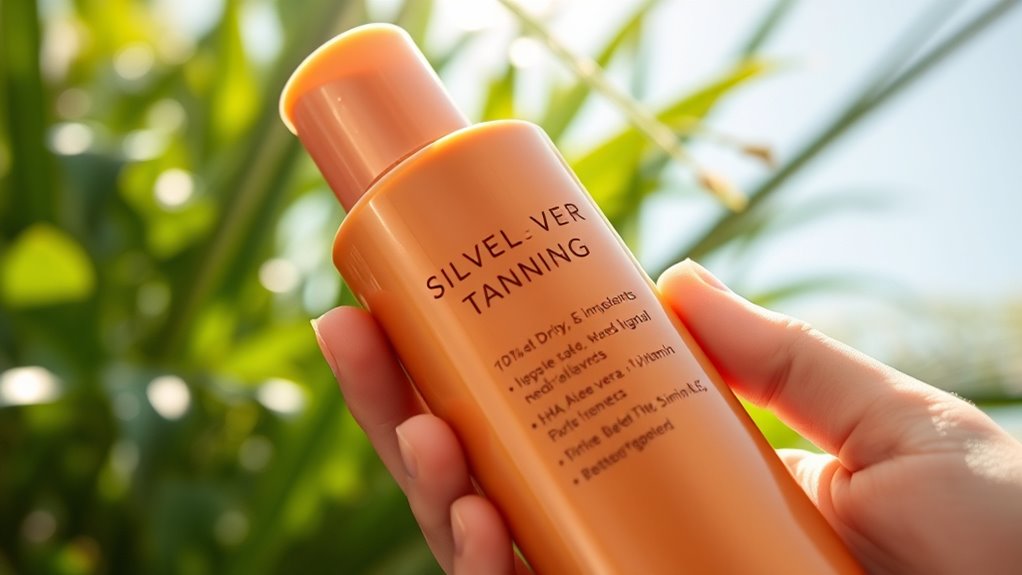
Understanding the key ingredients in tanning products helps you make safer and more effective choices. Dihydroxyacetone (DHA) is the main active ingredient, reacting with skin’s amino acids to produce a temporary color without UV exposure. Erythrulose is often added for longer-lasting results, developing more slowly. Secondary ingredients like tyrosine derivatives and naphthoquinones can boost tanning effects, while dimethyl isosorbide (DMI) improves delivery and absorption. Hydrators such as aloe vera, hyaluronic acid, glycerin, shea butter, and argan oil keep your skin moisturized, smooth, and healthy during tanning. For safety, always patch test first, use products as directed, avoid inhalation, and protect sensitive areas. Choosing formulas with certified ingredients reduces risks, helping you achieve a safe, natural-looking tan. Additionally, understanding sunless tanning ingredients can help you select products tailored to your skin type and desired results. Being aware of climate control technologies can also inform your choices to maintain your tan in various environmental conditions. Regularly researching product formulations can further enhance your safety and satisfaction with sunless tanning. Incorporating ingredient transparency in product labeling allows consumers to make more informed decisions about their tanning products. Moreover, advancements in AI discoveries are paving the way for innovative skincare solutions that could transform the industry.
How to Achieve Even Application and Natural-Looking Results

Achieving an even, natural-looking tan starts with proper preparation. Exfoliate your skin thoroughly about 24 hours before applying to remove dead cells, focusing on dry areas like elbows, knees, and ankles for uniform absorption. Moisturize dry patches the day before to prevent patchiness, and avoid deodorants or perfumes beforehand, as they can interfere with the tan. Make sure your skin is clean and completely dry before application. Use a soft velour application mitt to apply self-tanner in circular motions or smooth strokes, blending edges around wrists, ankles, and hairline to avoid harsh lines. Apply evenly across all exposed areas, including face and neck, and use lighter amounts on drier spots. Incorporating techniques like body awareness during application can help ensure even coverage and better results. Proper skin preparation is especially important because it significantly enhances the application process and the overall appearance of your tan. Additionally, understanding your skin’s drainage system can help you identify areas prone to uneven tanning or patchiness. Being aware of your skin’s texture and hydration levels can further improve application outcomes. Remember that proper skin preparation plays a crucial role in achieving a flawless, streak-free tan. Allow the product to dry fully before dressing, and avoid water or sweating for at least 12 hours to ensure a natural, streak-free glow.
Comparing Temporary Bronzers and Long-Lasting Tanning Formulas
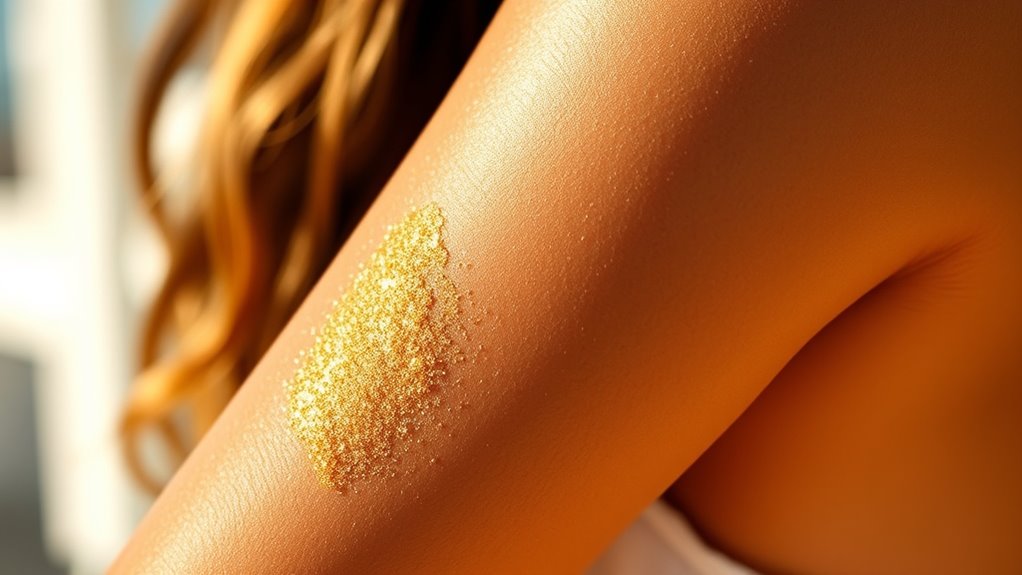
Temporary bronzers and long-lasting tanning formulas serve different needs and preferences, offering distinct benefits and drawbacks. Bronzers give you instant color by depositing pigments on the skin’s surface, which wash away easily—ideal for quick, single-event use. They come in creams, powders, and lotions, and require daily reapplication to maintain the look. In contrast, DHA-based formulas react with skin proteins to produce a semi-permanent tan lasting 3-7 days, making them more suitable for extended wear. These formulas include lotions, mousses, and sprays, often needing less frequent application. Some products combine both for immediate and lasting effects. While bronzers suit all skin types and are simple to use, DHA formulas need careful application and skin preparation. Understanding the different types of tanning products can help you make an informed choice that best fits your preferences. Additionally, paying attention to product ingredients can enhance safety and results, especially for sensitive skin. Proper skin preparation can also improve the evenness and longevity of your tan. Being aware of self-tanning techniques can further optimize your results and prevent streaks or uneven coloration. It’s also beneficial to consider product durability to match your desired duration of the tan.
Tips for Extending the Longevity of Your Sunless Tan

To make your sunless tan last longer, proper skin preparation is essential. Start by thoroughly exfoliating to remove dead skin cells, creating a smooth surface that helps the tan adhere evenly and reduces early fading. Use a pH-balanced cleanser beforehand to keep your skin in ideal condition for color retention. Avoid applying lotions or oils before tanning, as they can hinder absorption and cause uneven results. Ensure your skin is clean, oil-free, and free of deodorant or makeup for proper bonding. During application, use light, even layers and allow each to dry completely. Post-application, avoid sweating, swimming, or showering for at least 12 hours, and moisturize daily with gentle, tan-friendly products to slow skin shedding and maintain your glow longer. Additionally, choosing electric bikes with appropriate features can make outdoor activities more enjoyable and efficient, supporting your skincare routine through active movement. Proper candle safety precautions are also important when doing at-home tanning to prevent any hazards or accidents during the process. Being aware of headphone types and how to properly care for them can ensure a more enjoyable and uninterrupted experience during your relaxation time. Staying informed about the latest AI entertainment innovations can inspire fun and engaging ways to unwind after your skincare routine.
Popular Brands and Consumer Experiences
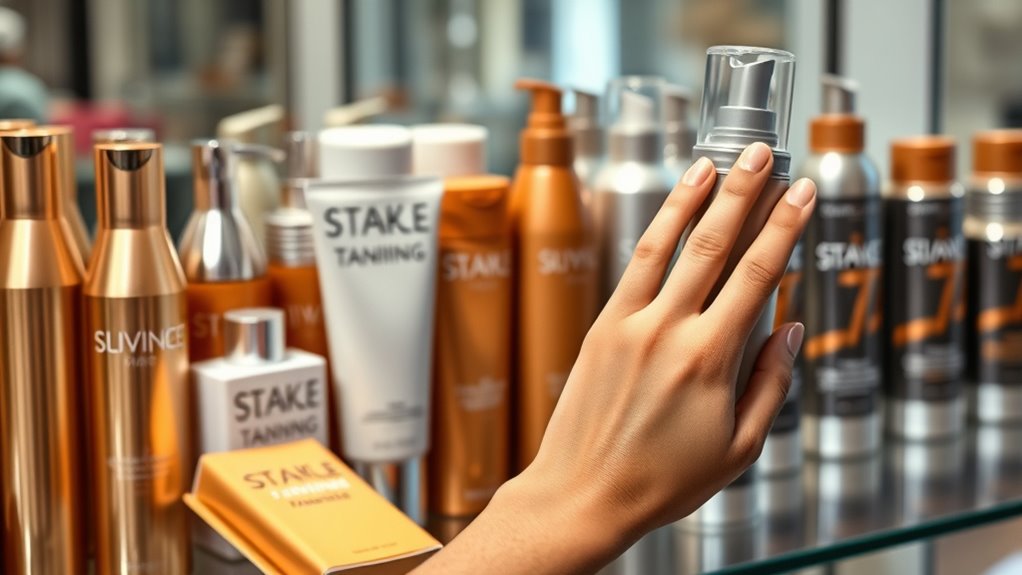
When choosing a sunless tanning product, knowing which brands are trusted and what others have experienced can help you make the right decision. Popular brands like Coco & Eve are praised for their easy-to-use formulas and natural-looking results, though some users notice greenish undertones initially. Isle of Paradise offers self-tanning drops and water that deliver a subtle glow, while L’Oréal Paris and St. Tropez are known for their reliable products and variety, ensuring consistent results. Sunless, Inc. focuses on skin health and moisture, catering to those with sensitive skin. Consumer feedback highlights fast-drying formulas, customizable shades, and hydration benefits. Overall, many users are satisfied with these brands for achieving a natural, sun-kissed look without UV exposure. Understanding product formulas can help you select the best option for your skin type and desired outcome. Additionally, being aware of lifestyle factors such as skin sensitivity and hydration can influence your choice of product to achieve optimal results.
Benefits of Choosing Sunless Tanning Over UV Exposure

Choosing sunless tanning over UV exposure offers significant health benefits, primarily by reducing your risk of skin cancer. UV rays damage your skin’s DNA, increasing the chances of melanoma and other skin cancers, while sunless tanning products like DHA only color the outer skin without causing harm. Unlike UV tanning, which accelerates aging and damages collagen, sunless options avoid these effects and help maintain healthier skin long-term. The ingredients in self-tanners are FDA-approved and safe when used correctly, reacting only with dead skin cells. Additionally, people who choose sunless tanning tend to adopt better sun protection habits, like applying sunscreen and wearing protective clothing. Overall, sunless tanning provides a safer, controlled way to achieve a bronzed look without the risks associated with UV exposure.
Limitations and Precautions When Using Self-Tanners
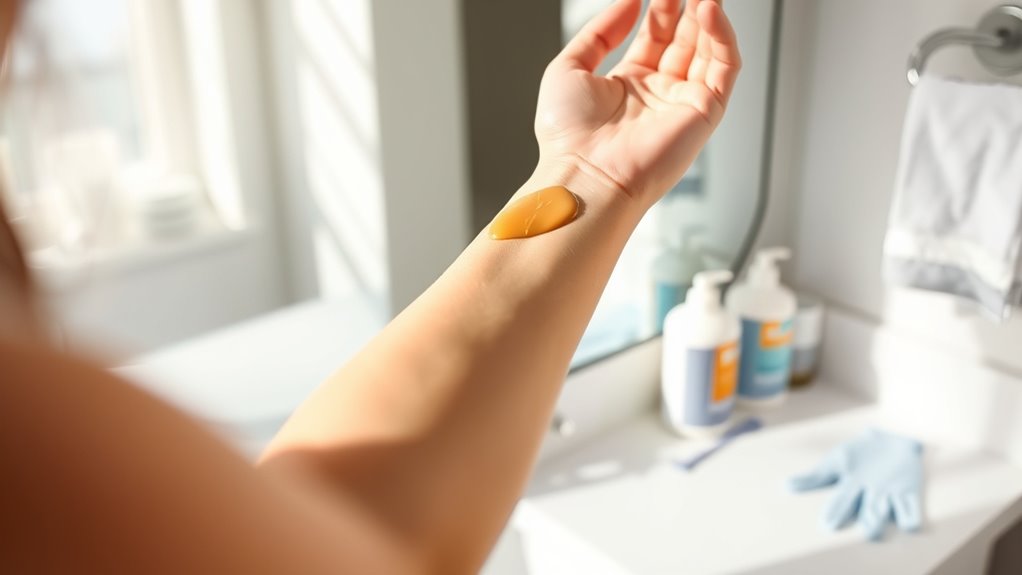
Self-tanners can help you achieve a bronzed look safely, but it’s important to be aware of potential risks and proper use. Some products contain preservatives like parabens or formaldehyde, which may cause skin or respiratory irritation. Always check labels for harmful ingredients or formaldehyde synonyms to avoid exposure. Self-tanners can trigger skin reactions, especially if you have sensitive skin or avoid exfoliating, leading to clogged pores or breakouts. DHA, the active ingredient, generates free radicals that increase oxidative stress, especially with sun exposure, accelerating skin aging. Remember, self-tanners don’t offer UV protection, so applying sunscreen is essential. Use reputable products, perform patch tests before full application, and follow instructions carefully to minimize adverse effects and ensure a safe tanning experience.
Innovative Trends in Sunless Tanning Technologies
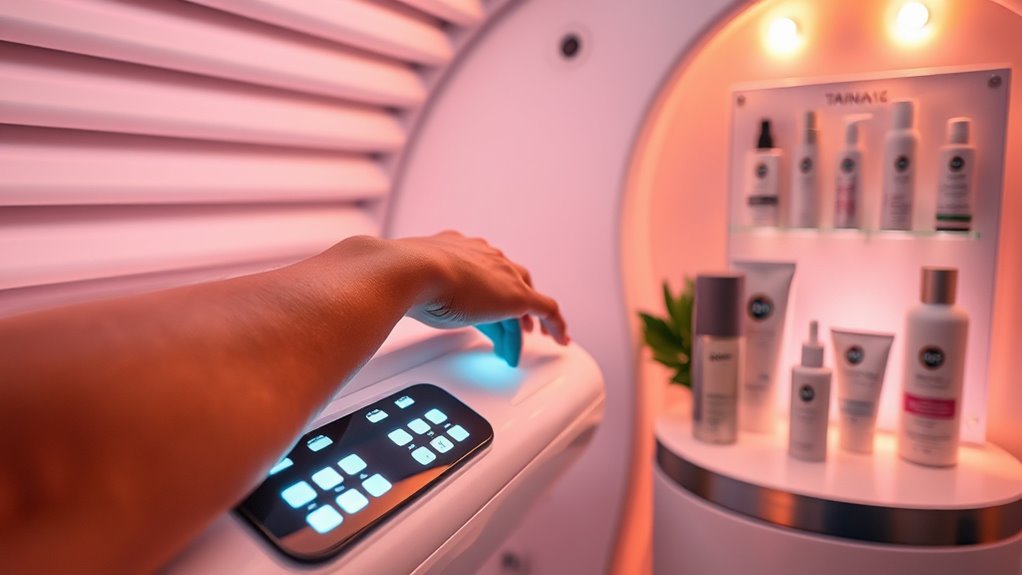
Advances in sunless tanning technologies are transforming the industry by integrating skincare benefits into tanning products. You’ll find multifunctional solutions that not only give you a flawless glow but also boost skin health with nourishing ingredients like fermented mushrooms and hyaluronic acid. These formulations aim to deliver wellness benefits similar to natural sunlight without UV exposure, meeting the growing consumer demand for products that combine skincare with tanning. Notable examples include James Read’s Self Glow and Ultra Violette’s Super Glow drops. The clean beauty movement also influences innovation, leading to non-toxic, DHA-free options with eco-friendly packaging. These trends reflect a shift towards safer, more effective tanning solutions that prioritize skin health, sustainability, and personalized care, making sunless tanning more versatile and beneficial than ever before.
Best Practices for Preparing and Removing Sunless Tans

Preparing your skin properly before applying a sunless tan and knowing how to remove it effectively are key to achieving a smooth, even glow. Start by exfoliating thoroughly 24 hours beforehand using a pH-balancing scrub to remove dead skin cells, ensuring a more even application. Avoid high-pH products like bar soaps or in-shower moisturizers that can interfere with DHA absorption. Shave or wax at least 24 hours prior to prevent open pores and uneven color. On application day, skip deodorants and perfumes to avoid staining or chemical reactions. Moisturize dry areas such as elbows, knees, and ankles beforehand to prevent over-darkening. After the tan, wait 6-8 hours before showering, then use lukewarm water and pat dry. Gentle exfoliation and natural remedies like baby oil or baking soda paste can help fade or remove the tan.
Frequently Asked Questions
Can Sunless Tanners Cause Skin Allergies or Sensitivities?
Yes, sunless tanners can cause skin allergies or sensitivities. You might experience redness, itching, or rashes after applying products containing DHA or other ingredients like fragrances and botanicals. To reduce risks, perform a patch test first and choose products formulated for sensitive skin. Keep your skin moisturized and consult a dermatologist if you notice persistent irritation, especially if you have pre-existing skin conditions like eczema.
Are There Natural or Organic Options for Sunless Tanning Products?
Imagine you’re back in the days of Cleopatra, but now you want a safe glow without risking your skin. The good news is, there are natural and organic sunless tanning options. You can choose products with plant-derived DHA, organic oils, aloe vera, and essential oils. These formulations are free from synthetic chemicals, cruelty-free, and gentle on your skin, giving you a beautiful, natural-looking tan without compromising your health or the environment.
How Do I Choose the Right Shade for My Skin Tone?
When choosing the right shade for your skin tone, start by identifying whether you have fair, medium, or dark skin. Consider your undertones—cool, warm, or neutral—to select a shade that complements naturally. For fair skin, go for lighter hues; medium tones suit darker shades; dark skin benefits from deep bronze. Always test a small area first and gradually build color to achieve a natural, flawless look.
Can Sunless Tanners Be Used on the Face Safely?
Think of your face as the crown jewel—delicate and in need of gentle care. Sunless tanners can be safe if you choose products formulated for facial use, avoid spray tans that might be inhaled, and always do a patch test first. Keep products away from your eyes and mucous membranes, apply in well-ventilated areas, and pair with sunscreen. With caution, you can enjoy a bronzed glow without risking skin damage.
Do Sunless Tanning Products Stain Clothing or Bedding?
You might notice sunless tanning products stain your clothing or bedding if you don’t let the tan fully dry. Dyes and DHA can transfer onto fabrics before absorption, especially if you apply too close to bedtime or wear loose, dark clothes afterward. To prevent stains, hydrate your skin beforehand, choose transfer-minimizing formulas, and wear protective clothing during and after application. Acting quickly with stain removal methods helps if stains happen.
Conclusion
Embracing sunless tanning elevates your glow without risking your skin’s health—it’s truly a game-changer. By choosing the right products, applying them evenly, and following best practices, you’ll achieve a radiant, natural-looking tan that rivals the sun itself. Remember, with the right knowledge and care, your flawless tan can last longer than you’d ever imagined—transforming your skincare routine into a luxurious ritual. Shine confidently and let your skin tell a story of elegance and health.

